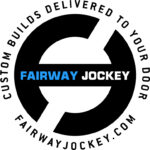Nothing compares to that giddy Christmas-morning feeling when a new custom club or, even better, set of custom clubs arrives perfectly wrapped at your door. But while you’re likely to have spent some face-to-face time with your club-fitter, the folks who build these world-class weapons generally remain under the radar. To shed light on their contributions and why custom-building is more than worth the investment, we spoke to David McKee, build shop manager for leading custom-club builder Fairway Jockey.
Q: How did you reach your current position with Fairway Jockey?
David McKee: I graduated Arizona State University’s Professional Golf Management Program in 2008. I was a Class A PGA of America pro for a while, then took a job at a local custom clubmaker, where I worked for eight years before coming on board with Fairway Jockey when it moved operations to Scottsdale in 2017.
Q: You’re a builder, not a sales guy, but give us the elevator pitch for why serious players should be going to a custom builder such as Fairway Jockey for their next club or set of clubs.
DM: I like to compare the custom-club business to customizing a car. Sure, you can buy a car at the dealership, and they can do a few things to make it nicer. But if you want top-end performance and true customization, you have to go to a place geared for that — one that can add computer chips and superchargers and all that.
Q: You oversee Fairway Jockey’s team of club builders. What do you look for when you’re hiring someone new?
DM: One of my favorite interview questions is, “If I give you this desk from Ikea, can you put it together?” Guys that are hesitant probably don’t have the manual dexterity or the skill set. Someone who never built a golf club but has been a carpenter or a mechanic, he’s got the skills within his hands. Still, there’s always a training process. I don’t let any new guys touch customers’ equipment until I’ve seen them fall and get back up and figure it out. Training can take anywhere from a couple of weeks to three months depending on their knowledge and skills. It takes time to learn our processes and systems, as well as OEM specs.
Q: What’s among the more difficult tasks that club builders face?
DM: Marrying up different companies’ specs. If we’re building a full set of Callaways, that’s pretty standard. But if I have, say, Callaway irons and Titleist wedges — a brand-agnostic set — their builds are different. Marrying up head weights and specs can be tricky. If we have a clubhead that’s too heavy, we might have to drill some weight out of the hosel. If we have a head that’s too light, we may need to reach out to the manufacturer to send us a different head. There’s a lot of give and take when you’re building a brand-agnostic set, because in the end it still needs to feel and perform like a unified set.
Q: What else can be challenging?
DM: OEMs are starting to play with the lengths throughout a set geared to higher handicappers. Years ago, you’d always have a ½-inch difference between clubs no matter what. They started to realize that using a little extra length in the longer irons might give those players more of a benefit. Player-development clubs these days have greater gapping in the longer irons, which flows back down to a ½-inch in the shorter irons. So, if you’re trying to make a blended set or a combo set, that can get tricky in terms of lofts, swingweights and various other things.
Q: You’ve built clubs for many Tour pros — are they your finickiest customers?
DM: Over the years, I’ve worked with several Tour players who are very specific as to feel. There was an LPGA pro who, when I handed her the club, she didn’t even have both hands on the grip before she said, “Nope, the grip’s too small.” I went back and added two wraps of tape. “Nope, grip’s too big.” There was an older pro who asked me to tip a shaft an eighth of an inch. I said, “You know, you’re probably not going to feel a difference with that.” He said, “Oh, I’ll feel it, trust me.” There are players who have that incredible level of feel.
Q: Amateurs must bring their own challenges.
DM: Nothing really surprises me anymore. Or maybe I should say that I’m not surprised that I get surprised every day. Some of the things people ask you to do, some of the garage stuff I’ve had to fix! One guy used to put yarn inside his driver to increase head weight. Another would put sand in the shaft to increase swingweight. All the guys who want to build a 50-inch driver, never mind that 48 inches is the maximum allowed. I could go on for days.
Then you have the guys who say, “If it’s not played on Tour, I’m not going to play it.” But after they go through a fitting and end up having something built that isn’t necessarily played on Tour, suddenly they’re playing the best golf of their lives. They open their mind and take advantage of our expertise.
Q: In the end, that expertise is one of Fairway Jockey’s strongest selling points, right?
DM: Yes, and also that you’re not limiting your possibilities. If I want to play my best, and I’m spending a fair amount of money to do so, why limit myself and what I’m able to achieve, or the things I have at my disposal? So, it’s also the variety of shafts and heads, the whole bespoke aspect of what we do.
Click or tap here to learn more about Fairway Jockey.


